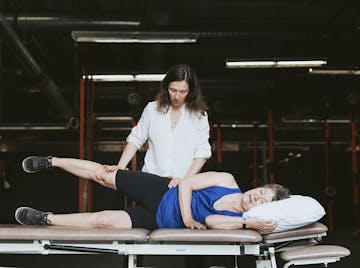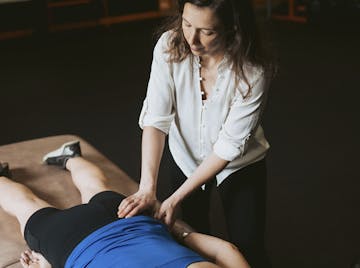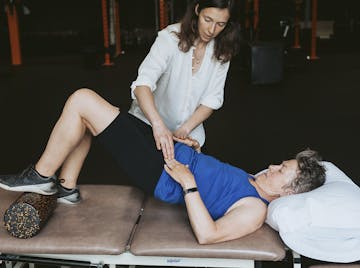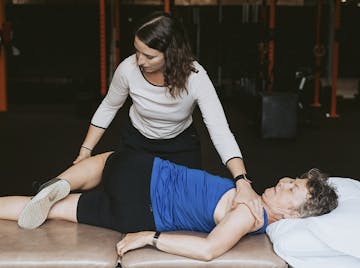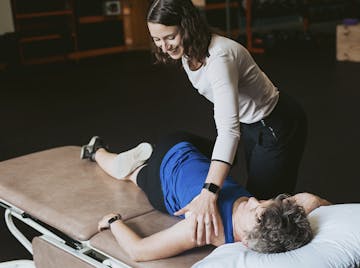The hip (acetabulum) is the largest joint and strongest in the human body, and many major nerves and arteries pass through it. The hip is a multiaxial, synovial ball and socket joint formed between the os coxa (hip bone) and the femur.
The rounded projection or ball (femoral head) at the top of the thigh bone (femur) fits into the pelvic girdle's socket (acetabulum). Both the ball and socket are lined with cartilage, which cushions the joint.
The space in each ball and socket joint is lined with a thin membrane called the synovium. The synovium cushions the joint and secretes a lubricating fluid (synovia), which reduces bone friction and help with fluid movement.
Common Hip Injuries and Conditions
Common hip injuries and conditions include:
- Bursitis - typical symptoms include pain on the outside of the hip, thigh and/or buttocks
- Tendonitis - typical symptoms include pain in the hip flexor (the group of muscles that lets you bring your knee and leg toward your body) or groin.
- Labral Tear - pain in the hip or groin, limited range of motion, a sensation that the hip is locking, catching or clicking.
- Hip Impingement, also known as femoral acetabular impingement (FAI) - a limited range of motion due to the ball and socket of the hip joint not fitting together properly, also can cause pain and premature arthritis in young adults.
- Fracture - a break in the upper portion of the femur (thighbone). Most hip fractures occur in elderly patients with osteoporosis. In younger patients, it is typically the result of a traumatic injury, such as a fall from a ladder or vehicle collision. This is a serious injury with complications that can be life-threatening. Symptoms include:
- Inability to get up after a fall or walk
- Severe pain in the hip or groin
- Inability to bear weight on the injured side
- Brusing swellin in and around the injured hip
- Shorter leg on the side of the injured hip
- Outward turning of the leg on the side of the injured hip
- Dislocation - severe pain, typically unable to move the leg and leg position may appear abnormal compared with the other leg.
- Congenital Dislocation - baby is born with dislocated hip caused by incomplete hip development. May also be caused by breached birth. Other contributory factors can include heredity or if there is not enough fluid surrounding the child in the womb.
- Iliotibial Band Syndrome (also known as IT Band Syndrome) - the iliotibial band is a strong, thick band of tissue that runs down the outside of the thigh and extends all the way from the hip bone to the top of your shinbone. IT band syndrome causes an aching, burning feeling on the outside of the knee that sometimes spreads up the thigh to the hip.
- Snapping Hip Syndrome (also known as Coxa Saltans or dancer's hip) - characterized by an audible or palpable snapping or clicking in the hip when walking, running, sitting, or getting up from a chair. Symptoms can range from simply an annoyance to both pain and weakness during hip flexion and extension, which can interfere with the patient's functional mobility. The origin of snapping hip syndrome (SHS) is classified as external (most common), internal, or intra-articular (least common).
Why Physical Therapy?
Most cases of hip pain respond well to physical therapy. Many patients have been able to postpone and sometimes even avoid surgery altogether.
Conditions we have successfully treated:
- Hip Pain
- Arthritis*
- Tendonitis
- Groin Strain
- Trochanteric Bursitis
- Post Surgical Hip Replacement
Advantages of Physical Therapy:
- No side effects.
- Cost-effective.
- Supported by clinical research.*
- Customized to treat the underlying cause.
- Your Recovery Process:
- Pain Relief
- Recovery of Any Lost Hip Range of Motion
- Increased Strength
- Recovery of Walking and Functional Skills
- Independent Care
What are my treatment options?
- Drugs
- Epidural Injections
- Surgery
- Physical Therapy*
Components of Your Care:
- A thorough biomechanical evaluation.
- Extensive patient education.
- A customized treatment plan.
- Gentle hands-on techniques to relax the muscles.
- Effective joint mobilization techniques to decrease stiffness.
- Pain-relieving modalities such as ice, heat, ultrasound or electrical stimulation.
- Targeted stretching for tight muscles.
- Walking, stair climbing, sit-to-stand retraining.
- Balance exercises.
* Cited from the academic journal, Physical Therapy, 2005, pp. 907 – 971.
Visit our Medical Library for more information on hip pain.
Physical Therapy for Hip Pain
Everyone is different. You may require one or two visits, or an extended care plan over several weeks or months. If you’re ready for relief, and tired of “masking” your pain, treat the cause, not just the symptoms!

